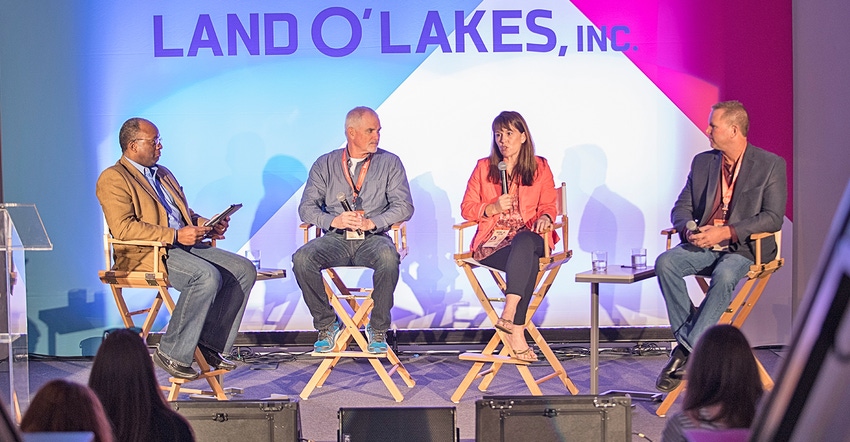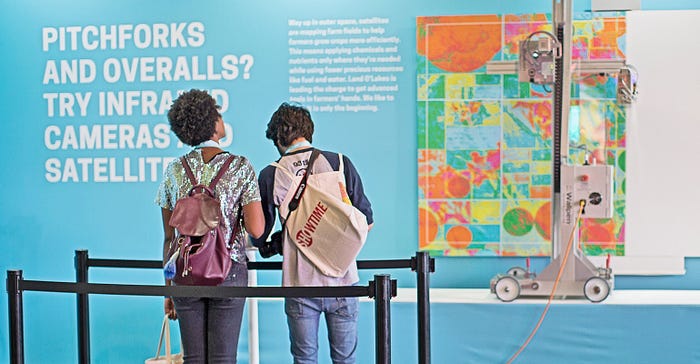April 4, 2018

Agriculture needs to do a better job of telling its story. Farmers hear that lament — and perhaps challenge — regularly, and companies and associations are stepping up to meet the challenge by taking their message to new places. A recent event known for music, art and tech lovers had a new exhibitor this year in Land O’Lakes, a farm cooperative.
Aiming to foster dialogue about how food is raised, the cooperative created The Food Effect, an interactive experience at South by Southwest (SXSW), as it is abbreviated — and “South by” as it’s referred to by those who attend. Farm Progress caught up with a couple folks who attended the event and took part in some Land O’Lakes panels held at SXSW.
“The thing about South by Southwest is that there is no way to prepare for it, whether you are in agriculture or not,” said Dave Ribeiro with Rib Arrow Dairy, Tulare, Calif. “It can be overwhelming, yet exciting, all in one big nutshell.”
He found, however, that there was a multitude of interaction to be had at the event, and those in attendance are “ready to absorb, to listen, to share and network, and it doesn’t have to be in the realm you’re looking for.” The event brings together people looking for new ideas, sharing information — who are basically on hand, ready to learn.

TALKING FOOD INSECURITY: Land O’Lakes connected its display at SXSW through this “phone bank.” Attendees could pick up a line and hear a story of a person dealing with difficulty — even in the United States — in feeding their family. For every “call” accepted, the cooperative donated $1 to a local food shelf.

For Joel Wipperfurth, director of ag technology, WinField United, the idea of SXSW was summed up by a Lyft driver he spoke with while in Austin, Texas, at the event. “I asked my Lyft driver what he thought about South by,” Wipperfurth says. “And they answered that South by was tomorrow’s America being formed. That made so much sense.”
He noted that aside from The Food Effect, he got a chance to take part in other panels and presentations at the event. “I was in a meeting where Matthew McConaughey and a marketing firm were discussing purpose-driven businesses.”
Ribeiro tells of his wander through SXSW, which included sitting in on a presentation from the producer of “Westworld,” who talked about artificial intelligence and other issues raised by the HBO series. “Near the end of the presentation, the producer said that he thought the panel had finished with a somber tone, so he invited his friend Elon to speak. That’s when Elon Musk came on stage.” Ribeiro was surprised: “It took me a minute to process, and the room went crazy.”
Musk, the electric car magnate, is the creator of the Tesla electric car and the founder of SpaceX.
That’s the kind of event SXSW is. What started as an alternative music festival has evolved into a kind of technology, arts and future-think event — essentially looking at tomorrow — for a wide range of people.
Telling the food story
For Wipperfurth, there was one surprise in his interaction with SXSW attendees: “They hadn’t formed their opinion yet. I didn’t have anybody come in attacking us on anything.”
The exhibit was aimed at sharing a lot of information for those that traveled through, from a definition of what food insecurity is to a look at gene editing. There was even a robot painting a mural, showing a farmscape with irrigation pivots — essentially, a painting of a satellite image.
“I asked someone what they thought about that display, and he was surprised to find that farmers use satellite imagery,” Wipperfurth says. “That's the kind of interaction.”
For Ribeiro, there was the eye-opener that the dialogue used in agriculture may not be the best way to communicate. “Sometimes with the circles we’re around, we all say things a certain way,” he says. “But on the panel I was on, the way the questions were asked was an eye-opener. I need to think twice or even three times before answering.”
He wondered how many times farmers, or anyone in a conversation, might be answering without thinking; and how many times two people may be saying the same thing, but in different ways. “We both may have the same passion, and say the wrong thing, because we don’t think before we speak,” he says.
Added Wipperfurth: “We need to use the language the consumer uses. For example, GMO is what people call biotechnology. Google ‛GMO,’ and you get 10 pages of information and none of it is good; but Google ‛biotechnology’ and you get a story of a hero scientist.”
As often happens, when true dialogue occurs, both gain knowledge. SXSW is a unique incubator of future thinking that offers agriculture a chance to tell the food story to an audience seeking new, solid information about the foods they eat.
“I had one person ask me what the difference was between organic milk and conventional milk, and I told them about $3 per gallon,” Ribeiro jokes. “There’s no difference in the product. We all produce safe milk. But the bigger message is that all farming is good farming, I’m not bashing anybody; the consumer just needs to be aware of that.”

TECH AND THE CONSUMER: Visitors to SXSW got a look at this robot, which was printing a detailed satellite map on a wall. It shows the sophistication of tech farmers use today to boost productivity.

Interactive learning opportunities
There were several panels and interactive exhibits at SXSW:
The Food Effect. This Land O’Lakes exhibit had an immersive experience that used virtual reality to provide what the company called a “front-row seat to experience innovative farming techniques in action.”
There was a gene editor at this exhibit, basically a larger-than-life DNA strand, that showed the ability of science to feed more people.
A (Car)bon Capture. This was essentially a half-buried car. The point there, Wipperfurth explains, was to show how agriculture can be part of the work to capture carbon in the atmosphere and help reduce CO2 issues. The point is that healthy soils contribute to cleaner air.
Insecure Lines. What this exhibit did was present a unique way to link the idea of food insecurity to the attendees. There was a bank of phone lines where attendees could listen to stories of families dealing with food insecurity. “We wanted to put a voice to this issue,” Wipperfurth says. “And we connected with the local community on this issue.”
Every time an attendee listened to a story, a meal was donated to a local food organization.
And there was a precision art display — in fact, a robot painting a satellite image along a wall. “I talked to someone looking at that exhibit,” Wipperfurth says. “They had no idea farmers used satellite imagery in their jobs.”
Connecting to consumers — and at SXSW it’s the consumer of the future — is a key goal for Land O’Lakes. The event provides a unique opportunity to tell modern agriculture’s story to a young, receptive audience.
About the Author(s)
You May Also Like






